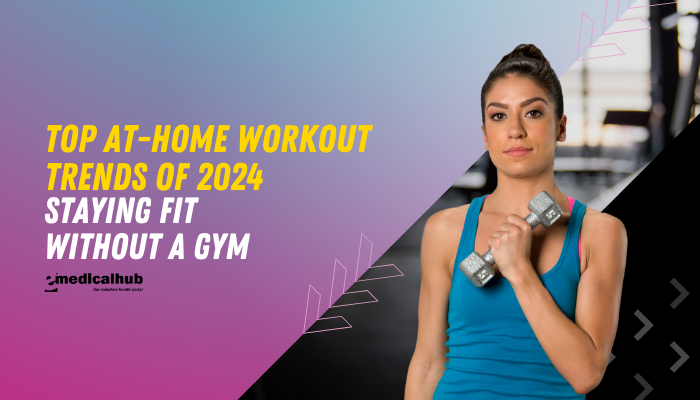Introduction
In the wake of shifting work schedules, pandemic-driven lifestyle changes, and growing technological innovations, at-home workouts have rapidly evolved from a necessity into a full-fledged fitness movement. This trend appears to remain strong going into 2024, with many people opting out of traditional gym memberships in favor of convenient, flexible, and highly personalized exercise routines they can do at home.
From virtual training platforms and AI-powered apps to sophisticated bodyweight routines and minimal-equipment circuits, there’s a wide spectrum of ways to keep fit without ever stepping into a conventional fitness center.
But with so many at-home methods available, how do you decide which approach suits you? What new trends and technology stand out, and how can you use them effectively? This article highlights the top at-home workout trends of 2024, examining their pros, cons, and practical tips for success.
Whether you have a dedicated home gym setup or just a small living room corner, these strategies can keep you active, motivated, and in shape no matter your schedule or location.
Disclaimer: The following information is for general educational use and does not replace personalized medical or fitness advice. Consult a healthcare professional before beginning any new exercise regimen, especially if you have underlying conditions or injuries.
Virtual and Live-Streaming Classes
Interactive Group Sessions
Among the most popular post-pandemic developments are live-streamed group classes hosted by certified trainers via Zoom, YouTube, or specialized fitness apps. Think:
- High-Intensity Interval Training (HIIT) Classes: 30-minute bursts of bodyweight or minimal-equipment intervals, perfect for limited space.
- Indoor Cycling Meetups: Virtual instructors lead real-time spin sessions, often paired with connected bikes that measure your cadence.
- Yoga and Pilates Streams: Softly-lit home studios and a webcam can mimic the social vibe of a real class, with real-time feedback from the instructor.
Advantages: Sense of community, real-time corrections, structured schedule.
Challenges: Potential for fewer modifications if the instructor can’t see you clearly, stable internet required, monthly subscription costs.
On-Demand Libraries
For flexible schedules, many companies offer vast on-demand video libraries. This allows you to pick from cardio, strength, dance, or mindfulness sessions of varied lengths. The 2024 trend pushes more personalization:
- AI-Recommended Classes: Apps that track your previous sessions and progress, then suggest the next best workout.
- Thematic Programs: E.g., a 4-week “core strength” track or “beginner yoga journey,” structured to progress intensities safely.
- Downloadable Sessions: For lower bandwidth or offline usage, especially if you want to travel and still maintain your routine.
Advantages: Complete time flexibility, wide variety, typically more cost-effective than in-person.
Challenges: Some may miss the accountability of live instructors or the camaraderie of real-time group sessions.
Minimalist Equipment Routines
Rise of Bodyweight Training
Bodyweight exercises remain a mainstay in at-home fitness:
- Push-Ups, Squats, Lunges, Planks: Foundational movements that require no equipment but can be scaled in difficulty.
- Progressive Overload: Master one variant before moving to more advanced forms (e.g., push-ups on knees → standard push-ups → diamond push-ups → single-arm push-ups).
- Core-Focused: Bodyweight workouts often incorporate multi-plane moves that challenge core stability.
Why 2024? People realize they can gain functional strength, improved mobility, and conditioning with zero cost and minimal space. Also, advanced techniques (pistol squats, handstand push-ups) challenge even seasoned athletes.
Simple Props with Big Impact
If you want slight progression from pure bodyweight:
- Resistance Bands: Lightweight and portable, offering variable resistance for arms, back, legs.
- Suspension Trainers (e.g., TRX): Attach to a door or ceiling anchor. Full-body functional exercises that harness your bodyweight at different angles.
- Jump Ropes: Great cardio alternative, needing just a little floor space and moderate ceiling clearance.
- Yoga Blocks and Straps: Aid in deeper stretches, alignment, and support for diverse skill levels.
Pros: Minimal cost, easy to store, fosters creativity.
Cons: Some might eventually want heavier loads for advanced strength gains.
Smart Home Gym Equipment and Wearables
AI-Powered Fitness Devices
As technology soars, 2024 sees a boom in smart workout gear:
- Mirror or Screen-Based Systems: Interactive displays that guide you through workouts, track form, and offer real-time corrections using AI.
- Connected Strength Machines: Some use electromagnetic resistance systems and built-in digital coaching (e.g., Tonal, Tempo).
- Smart Dumbbells/Kettlebells: Integrate sensors to measure range of motion, reps, and speed, feeding data to your phone for analysis.
Advantages: Personalized feedback, motivational metrics, structured programs.
Drawbacks: High upfront cost, subscription fees, reliance on stable Wi-Fi.
Wearable Health Trackers
Smartwatches and fitness bands remain essential for at-home fitness:
- Heart Rate Monitoring: Keep track of intensity zones to ensure you’re working effectively.
- Sleep and Recovery Tracking: Vital for optimizing workout scheduling, especially if you’re doing intense regimens at home.
- Integration with Virtual Classes: Some wearables can sync HR or caloric burn stats to live classes, letting you see performance compared to others.
Caution: Over-reliance on data can hamper “mindful” aspects of exercise. Remember to incorporate internal cues on fatigue or strain.
Virtual Reality (VR) and Gamified Workouts
VR Fitness Apps
Virtual Reality systems like the Oculus Quest (now Meta Quest) or HTC Vive open a realm of active games:
- Boxing and Dance: Slash or punch to rhythms (e.g., Beat Saber, Holodance).
- Adventure and Sports Simulations: Racket sports, archery, or even VR cycling where you physically pedal on a stationary bike.
- Real-time Metrics: Calorie estimates, leaderboard challenges, fosters an immersive, playful environment.
Pros: Highly engaging, transforms workouts into fun experiences.
Cons: Requires VR headset investment, potential motion sickness, or small space concerns.
Gamification Beyond VR
Even without VR, 2024 sees expansions in game-based exercise:
- Mobile Apps (Zombies, Run!, for example) turn runs or chores into story-driven quests.
- Smart exercise bikes with built-in racing games or scenic routes.
- Dance-based Video Games (Just Dance, etc.), engaging families for at-home cardio sessions.
Mental Wellness + Movement
Fusion of Yoga, Mindfulness, and Cardio
After the pandemic, more folks value mental well-being as part of fitness:
- Movement & Meditation: Short flows combining vinyasa yoga with breathwork, followed by guided relaxation.
- HIIT + Mindful Cooldown: Intense intervals culminating in gentle stretching with mindfulness to reduce stress and promote recovery.
- Pilates/Barre with a mindful approach: Focusing on posture and muscle engagement, bridging mental focus with precise movements.
Virtual Group Therapy Workouts
Some platforms now integrate discussion on mental health or stress management with group exercise. This can transform a typical cardio session into a synergy of social support, positivity, and physical movement.
Balancing Safety, Progress, and Variety
Individualizing Your Program
- Assess Fitness Level: Beginners might find short sessions (10–20 min) 3–4 times/week a good start. Gradually scale up.
- Periodization: If intermediate/advanced, plan phases to avoid plateau—e.g., 6 weeks progressive overload, then a lighter recovery week.
- Include Rest and Recovery: Overtraining at home is possible. Respect rest days, incorporate foam rolling, or gentle yoga for restoration.
Minimizing Injury
- Form Checks: For online classes or new workouts, record yourself or watch tutorial videos to correct posture.
- Gradual Overload: Don’t jump from 0 to advanced moves. If you’re new to bodyweight training, start with modifications, building stability first.
- Warm-Up and Cool-Down: Simple dynamic stretches pre-workout and gentle static stretches post-workout can reduce strain.
Motivation and Accountability
- Workout Buddy or Online Community: Encouragement from friends or digital communities fosters consistency.
- Progress Tracking: Log your reps, sets, or run times. Wearable data or a simple notebook can reflect improvements, fueling motivation.
- Set Realistic Goals: Whether it’s losing 5 pounds, performing 10 push-ups, or 3 pull-ups, aligning short-term achievements with the bigger picture fosters momentum.
Real-World Examples
Busy Professional
A 30-something telecommuter sets up:
- Short 20-min daily sessions with a streaming HIIT class in the morning, minimal equipment needed.
- A quick VR boxing game in the evening for stress relief.
- Focus on consistency: 4 times weekly, mixing HIIT with one yoga session.
Reported benefits: More energy, stable weight, improved mood.
Retiree with Joint Concerns
A 65-year-old uses:
- Chair-based or low-impact classes from a virtual library.
- Gentle bodyweight strengthening plus resistance bands for muscle maintenance.
- Mindful approach to avoid aggravating knees. Possibly invests in a recumbent bike with interactive guided rides.
Outcomes: Increased functional strength, reduced joint discomfort.
Family-Focused
Parents incorporate daily 10-min family circuits:
- Group dance follow-alongs on YouTube.
- Quick breaks after remote learning or weekend gatherings to do “mini-challenges.”
- Emphasize fun, not formal workouts.
Result: Family bonding, kids stay active, all without needing to trek to a gym.
Frequently Asked Questions (FAQ)
- Do I need an expensive subscription or equipment for at-home workouts?
Not necessarily. Plenty of free content on YouTube or library apps exist. Bodyweight moves, resistance bands, or inexpensive dumbbells are enough for effective routines. - Can I build significant muscle mass at home without heavy machines?
Yes, with progressive overload via bodyweight advanced variations, weighted vests, or heavier dumbbells, it’s doable. However, if advanced muscle growth is the goal, eventually heavier equipment might help. Creativity and consistency matter a lot. - How do I avoid boredom with at-home workouts?
Rotate different classes or methods, like HIIT one day, yoga the next, or experiment with VR/games. Incorporate monthly “challenges” (push-up challenge, squat challenge) to stay motivated. - Are at-home workouts as effective as gym workouts?
They can be. Gym machines can provide heavier loads, but a well-structured bodyweight or minimal equipment program addresses cardio, strength, and flexibility quite successfully for general fitness. Achieving advanced strength goals might require specialized equipment, though. - Any suggestions for small spaces?
Focus on compact routines: yoga or bodyweight circuits that don’t require wide ranges (like jump roping might be tough). Plan dynamic moves carefully—like push-ups, squats, planks, lunges. Streaming classes often demonstrate small-space modifications.
Conclusion
The at-home workout revolution shows no sign of slowing down as we head into 2024, thanks to new technologies, creative routines, and a recognition that fitness can thrive beyond traditional gym walls. Whether you gravitate toward live-streaming group classes, advanced AI-driven home gym setups, immersive VR experiences, or minimal-equipment bodyweight circuits, there’s an option for virtually every preference and budget. Coupled with mindful scheduling and self-accountability, at-home exercises can yield robust gains in strength, endurance, and weight management—minus the commute or membership fees.
It’s important to approach home-based fitness with consistency and thoughtful progression—listen to your body, address form and technique, and keep variety in your plan. Tools like wearable trackers, VR games, or interactive platforms can enhance motivation, but the essential ingredient remains your commitment to regular movement. By blending convenience with creativity, the best of these new 2024 workout trends can help anyone craft an effective, enjoyable regimen in the comfort of their own living space. Embrace the flexibility, find the methods that resonate with you, and watch your health and fitness flourish outside the gym.
References
- Thompson WR, et al. Worldwide Survey of Fitness Trends for 2024. ACSM’s Health & Fitness Journal. 2023;27(1):9-20.
- American Heart Association. Physical Activity Recommendations. Updated 2022.
- CDC. Physical Activity Guidelines for Americans. 2nd ed. 2018.
- Garber CE, et al. ACSM position stand on exercise for healthy adults. Med Sci Sports Exerc. 2011;43(7):1334-59.
- Swisher AK, et al. Efficacy of home-based exercise. J Clin Exerc Physiol. 2017;6(1):29-35.
- Andersson G, Cuijpers P. Internet-based and other computerized psychological treatments. Lancet Psychiatry. 2016;3(3):271-278.
- Stanmore E, Stubbs B, Vancampfort D, et al. The effect of VR interventions on physical outcomes. Int J Behav Nutr Phys Act. 2021;18(1):77.
- Torgan CE. The role of AR/VR in modern exercise science. J Comput Sci. 2019;9:183-197.
- Haskell WL, et al. Physical activity and public health. Circulation. 2007;116(9):1081-1093.
- Thompson Coon J, et al. Cost-effectiveness of remote exercise interventions. BMC Public Health. 2014;14:118.
- Freedland KE, et al. Behavior therapy for weight management at home. J Behav Med. 2021;44:675–688.
- Cole-Lewis H, Kershaw T. Text messaging as a tool for behavior change. J Med Internet Res. 2010;12(5):e58.




